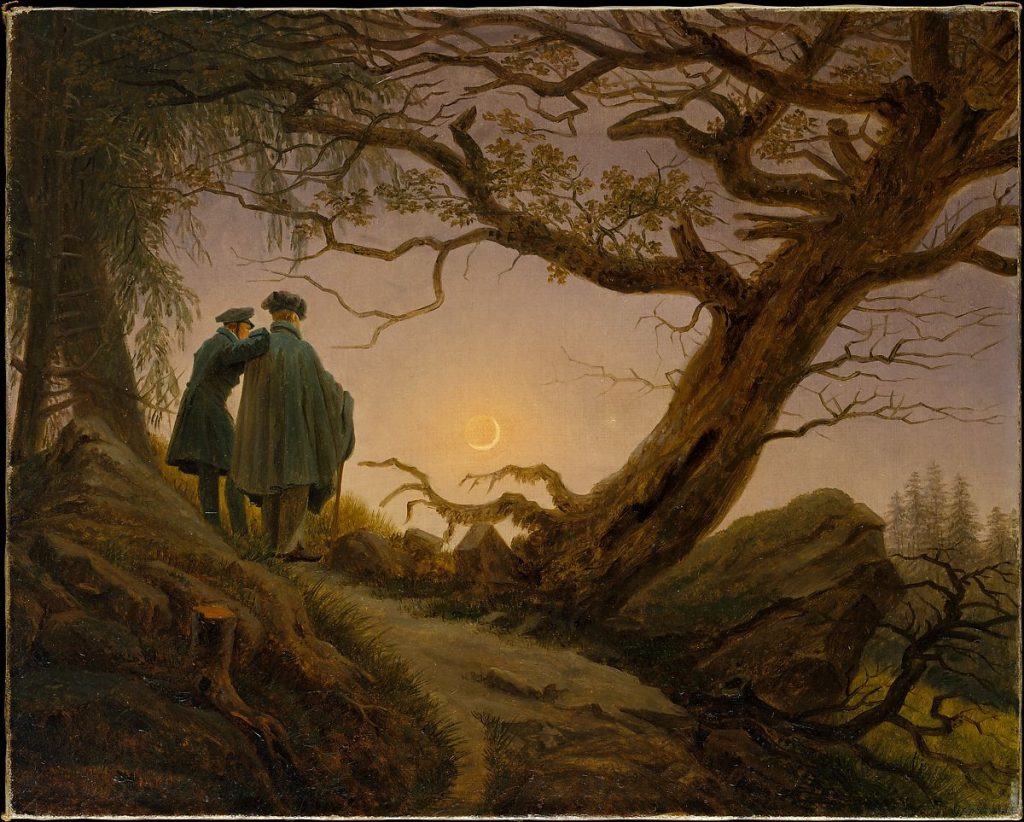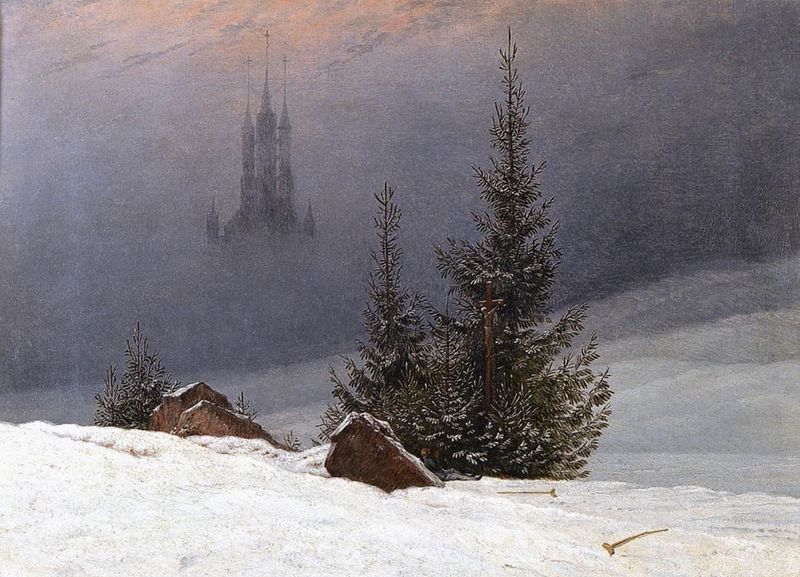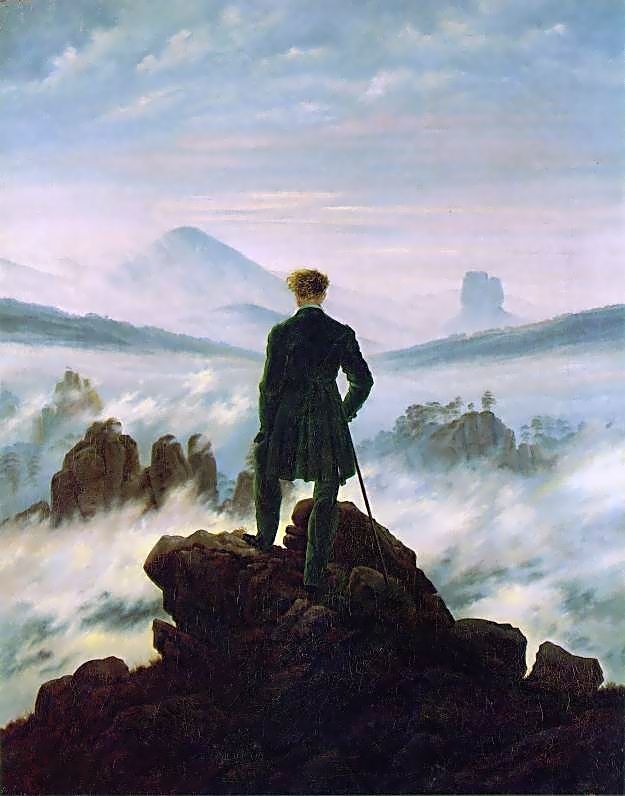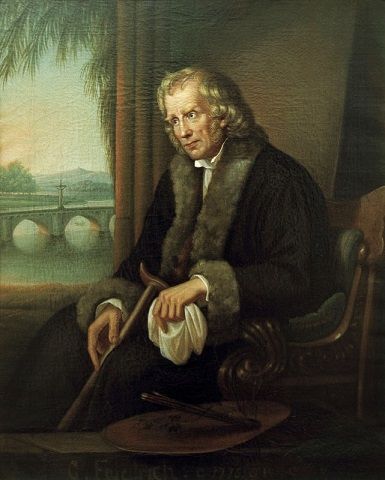German landscape painter
Caspar David Friedrich

Born into a strict Lutheran family, Caspar David Friedrich was the sixth of ten children. He became familiar with tragedy at an early age, losing his mother when he was seven, and two sisters to childhood illnesses. But maybe the most impactful loss which is said to have influenced his piece, The Sea of Ice, was the tragic death of his brother Johann, who drowned while trying to rescue thirteen-year-old Friedrich when he slipped through the ice.

Caspar David Friedrich, The Sea of Ice. 1823–1824 Oil on canvas
German: Das Eismeer
At the age of twenty, Friedrich enrolled at the Copenhagen Academy and while studying the masters, he developed his lifelong interest in nature and landscape. But it was his interest of spiritual and mystical poetry that would serve to influence his later work and his role as one of the key artists of German Romanticism.
Although Friedrich did not directly gain from his masters styles of Danish Neoclassicism, he was able to create his own themes and techniques and revived an interest in German landscapes.
Contemplative Works
I am captivated by Friedrich’s serene landscape paintings in nature where every so often lies a human presence amid an expansive landscape. I admire his ability to accurately portray a mood through nature without a need for expressions in people’s presence. Seen in many of his paintings, he places characters facing outward into the landscapes which physically reminds us of human insignificance in relation to nature.

In this work two figures are seen from behind so that the viewer may participate in their communion with nature. Friedrich is seen to the right, with his friend and disciple August Heinrich (1794–1822).

This painting is more than a calm desolate winter scene. Look closer and you can see a man resting against one of the rocks. His hands are raised in prayer; a wooden cross pressed into the foliage of the tree is the apparent object of his meditation.
Controversy from Critics

Caspar David Friedrich, Detail of The Cross in the Mountains (also known as the Tetschen Altar”), 1808, oil on canvas, 
More traditional portrayal of Christ’s crucifixion, seen from Pietro Perugino (last blogpost of Baroque Period)
His first major oil painting, The Cross in the Mountains (1807-08) (pictured left) commissioned as an altarpiece for a private chapel became controversial when Friedrich opened his studio to the public in 1808. Art critic Wilhelm von Ramdohr argued that a landscape like his could not function as an altarpiece. Critics disregarded the work for its beauty and were instead outraged that Christ’s crucifixion cross remained an afterthought to the landscape instead of the focal point it had been in traditional art.
In his response to critics he compared the sun-rays to the light of God saying the painting represented man’s continuous faith and hope in Jesus Christ still amidst the decline in formalized religion. Friedrich changed Christian art for the first time by infusing it with natures dominance.
Friedrich encouraged his contemporaries to reconsider the genre of traditional religious or history painting
Hidden Political Statements
Friedrich is known to have made political statements in his painting, often coded in subtle ways. In this work the costume the figure wears was apparently worn by students and others during Germany’s Wars of Liberation. During the time of this painting, the clothing was forbidden by Germany’s new ruling government. By deliberately depicting the figure in this outfit, he made a visual, understated, stand against the current government.

However, the political nature of this work did not stop there as his work (especially this painting) were adopted and abused by the Nazi regime as symbols of intense German nationalism. Because Friedrich replaced more literal illustration with merely suggestive messaging, his paintings were easily reinterpreted to fit new political intentions. It would take more than three decades, into the 1980s, for his work to be viewed and appreciated once again without the taint of Nazism.
The Stages of Life
In 1835 Friedrich suffered a stroke that left him partially paralyzed, although he managed to continue working until his death, reverting to the small-scale formats of his early years.

This is one of Friedrich’s last works before multiple strokes prevented him from working in oils. An allegory on the passing of time and the journey of life, the various stages of life are echoed in the five ships that move from the shore (start, birth) to the horizon (death, infinity), as well as in time as depicted from childhood to old age. Like many of his paintings the sky dominates a majority of the canvas, changing from shades of blue to a wide wash of orange and yellow in the center, placing the time of day as early evening. As the sun sets and the ships move out to sea, there is a sense of peace, completeness, and acceptance.
After several years of mental deterioration, Friedrich died in Dresden, May 7, 1840.

Works Cited:
https://www.caspardavidfriedrich.org/ http://romanticisminthevisualarts.blogspot.com/2012/10/caspar-david-friedrich-pictured-world.html https://search-credoreference com.ezproxy.capilanou.ca/content/entry/routromanticera/friedrich_caspar_david_1774_1840/0 https://www.theartstory.org/artist/friedrich-caspar-david/life-and-legacy/#biography_header https://medium.com/thinksheet/great-paintings-winter-landscape-by-casper-david-friedrich-4207f7ba83b2
One reply on “Neoclassicism, Romanticism, & Rococo”
Joanne,
Wow, great and in-depth work on C D F. You would not believe the number of students that have blogged on him over the years. He seems to resonate deeply with people. You are no exception to this as well as you’ve obviously made a connection to his work here. Terrific research and personal insights to his paintings. Very well done and I look forward to more of the same.
Jeff